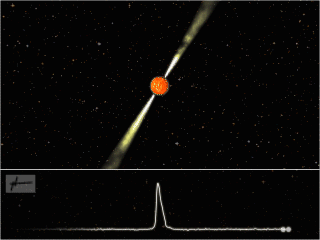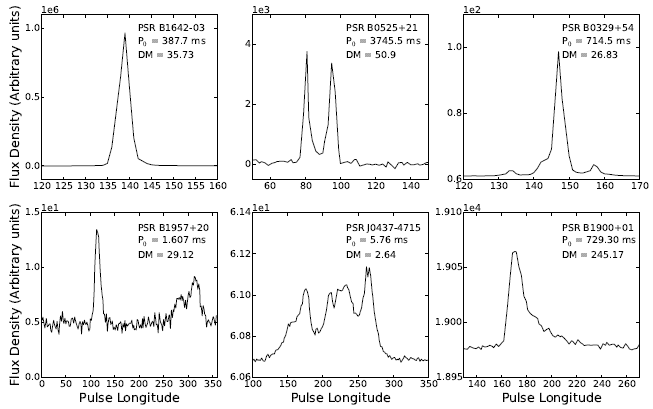Pulsar
A pulsar (from pulse and -ar as in quasar) is a highly magnetized rotating compact star (usually neutron stars but also white dwarfs) that emits beams of electromagnetic radiation out of its magnetic poles. This radiation can be observed only when a beam of emission is pointing toward Earth (much like the way a lighthouse can be seen only when the light is pointed in the direction of an observer), and is responsible for the pulsed appearance of emission. Neutron stars are very dense, and have short, regular rotational periods. This produces a very precise interval between pulses that ranges from milliseconds to seconds for an individual pulsar. Pulsars are one of the candidates for the source of ultra-high-energy cosmic rays. The periods of pulsars make them very useful tools for astronomers. Observations of a pulsar in a binary neutron star system were used to indirectly confirm the existence of gravitational radiation.

The rotating neutron star (or “lighthouse”) model for pulsar emission.
The Pulsar Ooty Radio Telescope New Digital Efficient Receiver (PONDER), which has been designed to operate along with the legacy analog system of the Ooty Radio Telescope (ORT). PONDER makes use of the current state of the art computing hardware, a Graphical Processing Unit (GPU) and sufficiently large disk storage to support high time resolution real-time data of pulsar observations, obtained by coherent dedispersion over a bandpass of 16 MHz. Four different modes for pulsar observations are implemented in PONDER to provide standard reduced data products, such as time-stamped integrated profiles and dedispersed time series, allowing faster avenues to scientific results for a variety of pulsar studies. Additionally, PONDER also supports general modes of interplanetary scintillation (IPS) measurements and very long baseline interferometry data recording.
The IPS mode yields a single polarisation correlated time series of solar wind scintillation over a bandwidth of about four times larger (16 MHz) than that of the legacy system as well as its fluctuation spectrum with high temporal and frequency resolutions. The key point is that all the above modes operate in real time. This paper presents the design aspects of PONDER and outlines the design methodology for future similar backends. It also explains the principal operations of PONDER, illustrates its capabilities for a variety of pulsar and IPS observations and demonstrates its usefulness for a variety of astrophysical studies using the high sensitivity of the ORT.

This figure shows the integrated profiles of a few pulsars, with a range of periods and DMs, observed during the test runs with PONDER. The flux density in arbitrary units is plotted against pulse longitude in degrees (one period = 3600degrees), for appropriately selected longitude range, where the pulsed emission is seen, in each panel. The pulsar name, period and DM are given in the top left corner of each panel.
PONDER was designed to provide capabilities for high time resolution observations with the ORT, which is an offset parabolic cylindrical antenna, used as a sensitive single dish telescope for monitoring pulsars and the solar wind.Previous pulsar studies with the ORT were performed with 9 MHz of bandwidth with typical time resolution of about 128 µs. Daytime observing at the ORT is allotted to the IPS studies, which are aimed at the regular monitoring of the solar wind over a wide area of the sky plane. In the conventional IPS measurements, the intensity scintillation over a 4 MHz bandwidth obtained with the central beam of the correlated-beam system was recorded at a sampling interval of 20 ms. In addition,it is proposed to use the ORT for Very Long Baseline Interferometry (VLBI) observations with telescopes in Russia, which also require Nyquist sampled voltage data at a very high time resolution.

Hardware architecture of PONDER.
